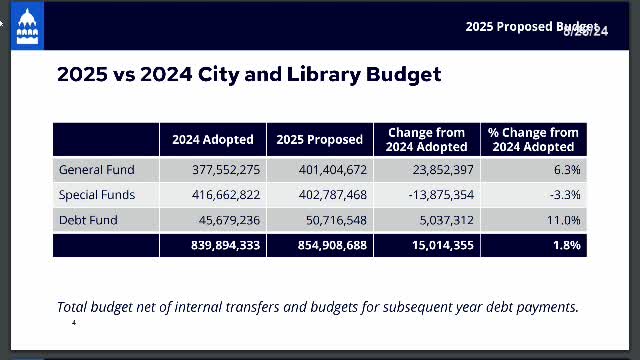City budget faces $194 million gap amid rising costs
August 28, 2024 | St. Paul City, Ramsey County, Minnesota
This article was created by AI summarizing key points discussed. AI makes mistakes, so for full details and context, please refer to the video of the full meeting. Please report any errors so we can fix them. Report an error »

In a recent government meeting, officials discussed the intricacies of the city’s budget for 2025, highlighting significant changes in funding sources and departmental expenditures. The budget process began with a projected gap of $19.4 million, primarily driven by inflationary pressures on salaries and benefits, as well as the phase-out of American Rescue Plan (ARP) funding.
The city’s general fund, which is largely supported by property taxes and local government aid (LGA), will see a property tax levy increase of 7.9% over the previous year, totaling approximately $225 million. Of this, about $175 million will support the general fund, while allocations for debt service, the public library, and the Port Authority will also be included. The estimated market value growth for properties in Saint Paul is modest at 0.7%, prompting discussions on how property value shifts will affect taxpayers.
A significant portion of the budget—82% of general fund expenses—is allocated to salaries and benefits, with police and fire departments accounting for nearly half of these costs. However, when special funds are included, this percentage drops to 51%, reflecting the city's broader financial commitments, including debt service and capital outlay costs.
The budget will fund 3,209 full-time equivalent positions, marking a 4.4% increase from 2024. Notable growth in staffing is seen in parks, public works, and fire departments, driven by new facilities and services. The meeting also addressed the importance of LGA, which is crucial for stabilizing local property taxes and ensuring the availability of essential services. Despite an increase in LGA funding for 2024, the anticipated growth for 2025 is minimal, raising concerns about the city's ongoing financial needs.
Officials emphasized the necessity of maintaining a responsible debt model to avoid significant spikes in future levies, ensuring that the city can meet its obligations without overburdening taxpayers. The meeting concluded with a commitment to transparency and further analysis of budget components, particularly regarding the separation of library funding and the impact of property tax shifts on residents.
The city’s general fund, which is largely supported by property taxes and local government aid (LGA), will see a property tax levy increase of 7.9% over the previous year, totaling approximately $225 million. Of this, about $175 million will support the general fund, while allocations for debt service, the public library, and the Port Authority will also be included. The estimated market value growth for properties in Saint Paul is modest at 0.7%, prompting discussions on how property value shifts will affect taxpayers.
A significant portion of the budget—82% of general fund expenses—is allocated to salaries and benefits, with police and fire departments accounting for nearly half of these costs. However, when special funds are included, this percentage drops to 51%, reflecting the city's broader financial commitments, including debt service and capital outlay costs.
The budget will fund 3,209 full-time equivalent positions, marking a 4.4% increase from 2024. Notable growth in staffing is seen in parks, public works, and fire departments, driven by new facilities and services. The meeting also addressed the importance of LGA, which is crucial for stabilizing local property taxes and ensuring the availability of essential services. Despite an increase in LGA funding for 2024, the anticipated growth for 2025 is minimal, raising concerns about the city's ongoing financial needs.
Officials emphasized the necessity of maintaining a responsible debt model to avoid significant spikes in future levies, ensuring that the city can meet its obligations without overburdening taxpayers. The meeting concluded with a commitment to transparency and further analysis of budget components, particularly regarding the separation of library funding and the impact of property tax shifts on residents.
View full meeting
This article is based on a recent meeting—watch the full video and explore the complete transcript for deeper insights into the discussion.
View full meeting
